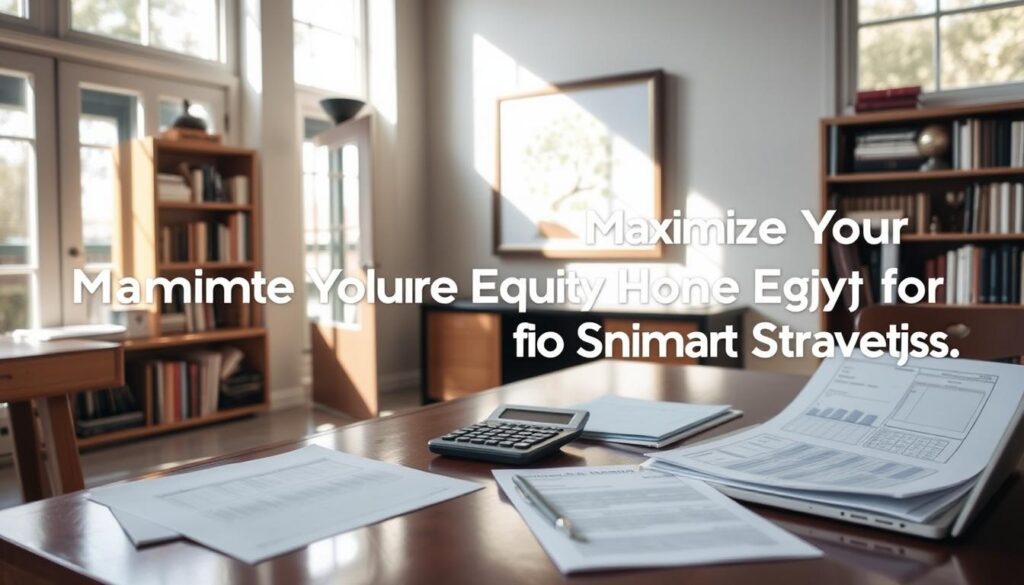Did you know that over 80% of U.S. homeowners have untapped potential in their home equity, yet fewer than 30% use it strategically? That’s billions of dollars sitting unused—a missed opportunity for growth, renovations, or financial flexibility. This guide reveals how to unlock that value through real success stories.
Imagine using your home’s value to fund dream projects or pay off debt, like the Smiths did with a Home Equity Investment (HEI) from Point, or the Johnsons’ smart strategy with Hometap. This guide breaks down how equity works, common pitfalls to avoid, and proven methods to grow your wealth. Let’s turn your home into a financial engine—starting today.
Understanding Home Equity Investment
Home equity financing offers homeowners a way to unlock value tied to their property. Let’s break down how it works. Your home equity is simply the difference between your home’s current market value and any remaining mortgage balance. For example, if your home is worth $300,000 and you owe $150,000, your equity is $150,000. This equity becomes a resource you can tap into through loans or lines of credit.
What Is Home Equity?
Think of equity as your ownership stake in your home. Over time, as you pay down your mortgage and home values rise, this number grows. It’s like a savings account tied to property growth. Home equity financing lets you access these funds without selling your home.
Benefits and Risks of Home Equity Investment
Benefits include lower interest rates compared to credit cards and flexible repayment terms. Many use it for renovations, education, or debt consolidation. But risks exist too—defaulting could lead to foreclosure. Let’s compare key options:
| Type | Example | Pros | Risks |
|---|---|---|---|
| HELOC | Line of credit | Flexible access | Variable rates |
| Cash-Out Refinance | Lump-sum loan | Large funds | Extended repayment |
| Home Equity Loan | Fixed-term loan | Predictable payments | Upfront fees |
Each choice affects your finances differently. Research thoroughly to align with your goals. Remember, home equity financing requires careful planning to balance advantages and potential downsides.
Essential Strategies for Home Equity Success
Smart home equity strategies require balancing market insights with practical steps. Start by tracking local housing trends and interest rates to spot opportunities. Whether you prefer traditional loans or newer digital tools, adaptability is key.
- Assess your equity value yearly to stay aware of your financial position.
- Compare loan terms: Fixed-rate loans offer stability, while adjustable options may save costs in low-rate environments.
- Set clear goals—whether paying off debt, expanding your home, or funding education.
A well-planned approach blends time-tested methods with modern tools. Here’s how:
| Method Type | Example | Pros | Cons |
|---|---|---|---|
| Traditional | Home Equity Loan | Fixed payments, predictable terms | Higher upfront fees |
| Innovative | Equity Investment Apps | Rapid approval, flexible uses | Potential variable rates |
Regularly review your plan with a financial advisor. Pairing these home equity strategies with expert guidance ensures your choices align with long-term goals. Stay informed to turn your home’s value into a reliable financial tool.
Real-Life Success Stories in Home Equity Investment
Real-life home equity stories show how everyday homeowners turn property value into opportunities. These examples prove that equity can fund renovations, pay off debt, or create income streams when planned wisely.
The Smith Family’s Journey
When the Smiths wanted to modernize their kitchen, they tapped into their home equity. A $25,000 loan covered appliances and cabinetry, raising their home’s resale value by 15%. “We prioritized features buyers want most,” says their financial advisor. Their strategy balanced cost and market appeal.
The Johnsons’ Investment Breakthrough
By converting a basement into a rental suite, the Johnsons added $400 monthly income. They secured a low-interest home equity loan and worked with contractors to stay under budget. This move also increased their home’s equity by $30,000 in two years.
Key lessons from these success stories:
- Target upgrades with proven ROI, like kitchens or bathrooms.
- Consult professionals to assess market demand and costs.
- Align loan terms with long-term financial goals.
Real-life home equity stories like these reveal that patience and research pay off. Explore more inspiring case studies to see how others balanced risk and reward. Every story highlights planning as the first step toward success.
How to Maximize Your Home Equity Investment
Smart planning turns potential equity into real value. Start by aligning home improvement financing choices with your long-term goals. Every decision you make now can boost resale value or lower future costs.

Budgeting and Financial Planning
Begin with a clear budget that includes:
- Project costs (materials, labor)
- Contingency funds (10-15% of total budget)
- Loan terms if using home improvement financing (e.g., low-interest loans from banks like Chase or Discover)
Leveraging Market Trends
Track trends to time upgrades for maximum impact. Key strategies include:
| Strategy | Action |
|---|---|
| Seasonal timing | Start projects in late winter for spring selling seasons |
| Local demand | Focus on improvements buyers prioritize in your area (use Redfin’s neighborhood reports) |
Use tools like Remodeler’s Market Forecast to identify high-ROI projects. Prioritize upgrades with over 70% ROI, like kitchen or bathroom remodels. Always compare home improvement financing rates to secure the best terms.
Assessing Risk and Reward in Home Equity
Every home equity move involves balancing equity investment risks with possible gains. Before acting, you must weigh how market shifts, loan terms, and personal finances could impact outcomes. Let’s break down what matters most.
- Market changes: Home values can drop, reducing your equity’s worth.
- Interest rates: Rising rates increase borrowing costs over time.
- Approval delays: Equity loans often take longer to process than standard mortgages.
| Risk Factors | Potential Impact |
|---|---|
| Market Downturns | Lower home value = less accessible equity |
| Variable Interest Rates | Monthly payments could jump unexpectedly |
| Extended Processing | Delayed access to funds during application |
Data shows 34% of borrowers face longer approval timelines for equity loans compared to traditional mortgages. To manage equity investment risks, compare loan terms carefully. Use online calculators to see how market trends might affect your equity’s growth. Consulting a certified financial planner can clarify how interest rates might shift over your loan term.
While equity offers cash now, its value depends on housing market trends. Stay informed about local real estate prices and interest rate forecasts. This helps you decide if the reward outweighs the risks for your unique situation.
Step-by-Step Guide to Get Started
Ready to turn your home’s value into actionable opportunities? Start with these clear, actionable steps to begin your home equity journey confidently.
Calculate your current equity by subtracting your remaining mortgage balance from your home’s appraised value. Use online budgeting for home equity calculators like Bankrate or Zillow to estimate market worth. Gather recent tax records and loan statements for accuracy.
2. Exploring Financing Options
Compare these financing paths to align with your goals:
| Option | Pros | Cons |
|---|---|---|
| Home Equity Loan | Lump-sum payout | Fixed repayment terms |
| HELOC (Line of Credit) | Flexible access | Variable rates |
| Cash-Out Refinance | Lower interest rates | Long approval process |
3. Consulting with Experts
Partner with a certified financial advisor to review budgeting for home equity strategies. Schedule a consultation with a licensed real estate appraiser to confirm your home’s current market value. Discuss options with mortgage lenders like Quicken Loans or LoanDepot for tailored advice.
Common Mistakes to Avoid
Home equity offers opportunities, but common home equity mistakes can turn those chances into costly missteps. Let’s spotlight three pitfalls to sidestep:
- Ignoring hidden fees: Closing costs or variable rates can eat into your savings. Review all charges before signing.
- Overestimating property value: Markets shift—don’t assume rapid appreciation. Use tools like Zillow or Redfin for realistic appraisals.
- Skipping contract details: Fine print in HELOC agreements often includes adjustable rates or repayment triggers. Missing these terms could trap you in unfavorable terms.
Data shows HELOC users lost over $387 billion in 2023-2024 due to poor choices. Two-thirds of borrowers also misjudged risk, per Harvard Business Review. To stay safe:
Always compare lenders, track market trends, and consult a financial advisor. Avoid using all your equity—keep a buffer for emergencies. Remember, even small oversights in common home equity mistakes can lead to big problems down the line.
Tools and Resources for Your Investment Journey
Maximizing your home equity starts with the right tools. Explore user-friendly resources designed to simplify financial planning for homeowners and boost confidence in your decisions.
Online Calculators and Financial Tools
Use these free tools to estimate equity, compare loan options, and track progress:
- Bankrate’s Home Equity Calculator (project loan costs and timelines)
- NerdWallet’s Mortgage Calculator (evaluate refinancing scenarios)
- Zillow Equity Analysis (visualize neighborhood trends and property value shifts)
Finding Professional Advice
Professional guidance ensures you avoid pitfalls. Here’s how to connect with experts:
- Search the National Association of Personal Financial Advisors (NAPFA) for fee-only advisors specializing in financial planning for homeowners.
- Consult a certified financial planner (CFP) to tailor strategies to your goals.
- Reach out to local real estate agents for market insights and neighborhood data.
Combine these tools with regular market research to stay informed. Trusted platforms like the Federal Reserve’s Homeownership Resources also offer free guides and webinars.
Conclusion
Every step in this home equity investment guide has shown how strategic planning turns homeownership into opportunity. From the Smiths’ renovation wins to the Johnsons’ market timing, real stories prove that smart choices lead to growth. Your journey starts with knowing your equity and aligning it with goals.
Risk assessment and budgeting tools outlined earlier help avoid pitfalls like overextending finances. Use online calculators and expert advice to stay on track. Remember, even small steps—like researching trends or consulting lenders—build momentum toward your vision.
Armed with this guide’s roadmap, you’re ready to act. Whether refinancing, renovating, or expanding equity, every decision now comes with clarity. Let the lessons from real homeowners inspire confidence. Your home’s value isn’t just about today—it’s a foundation for the future. Start exploring options today with the strategies that work.



